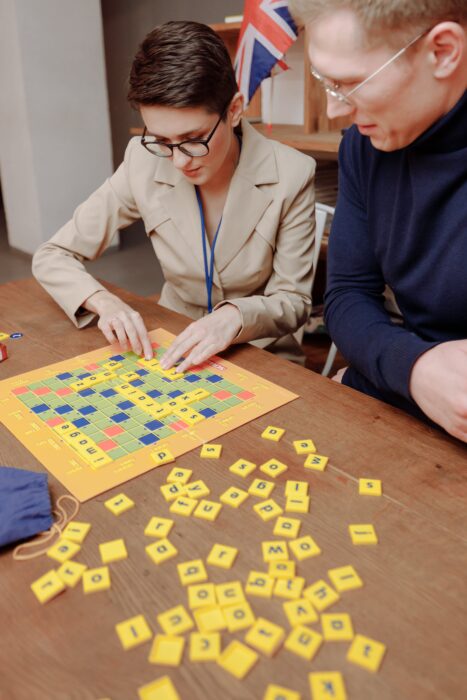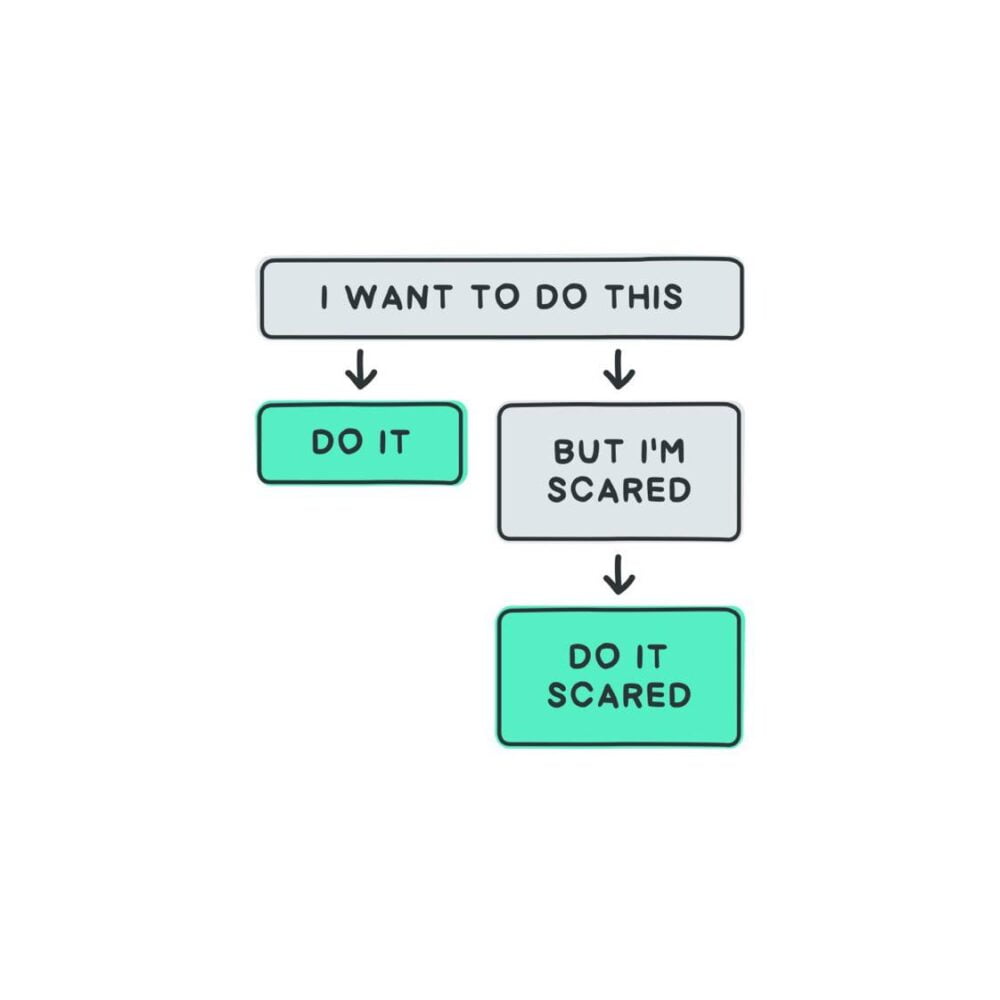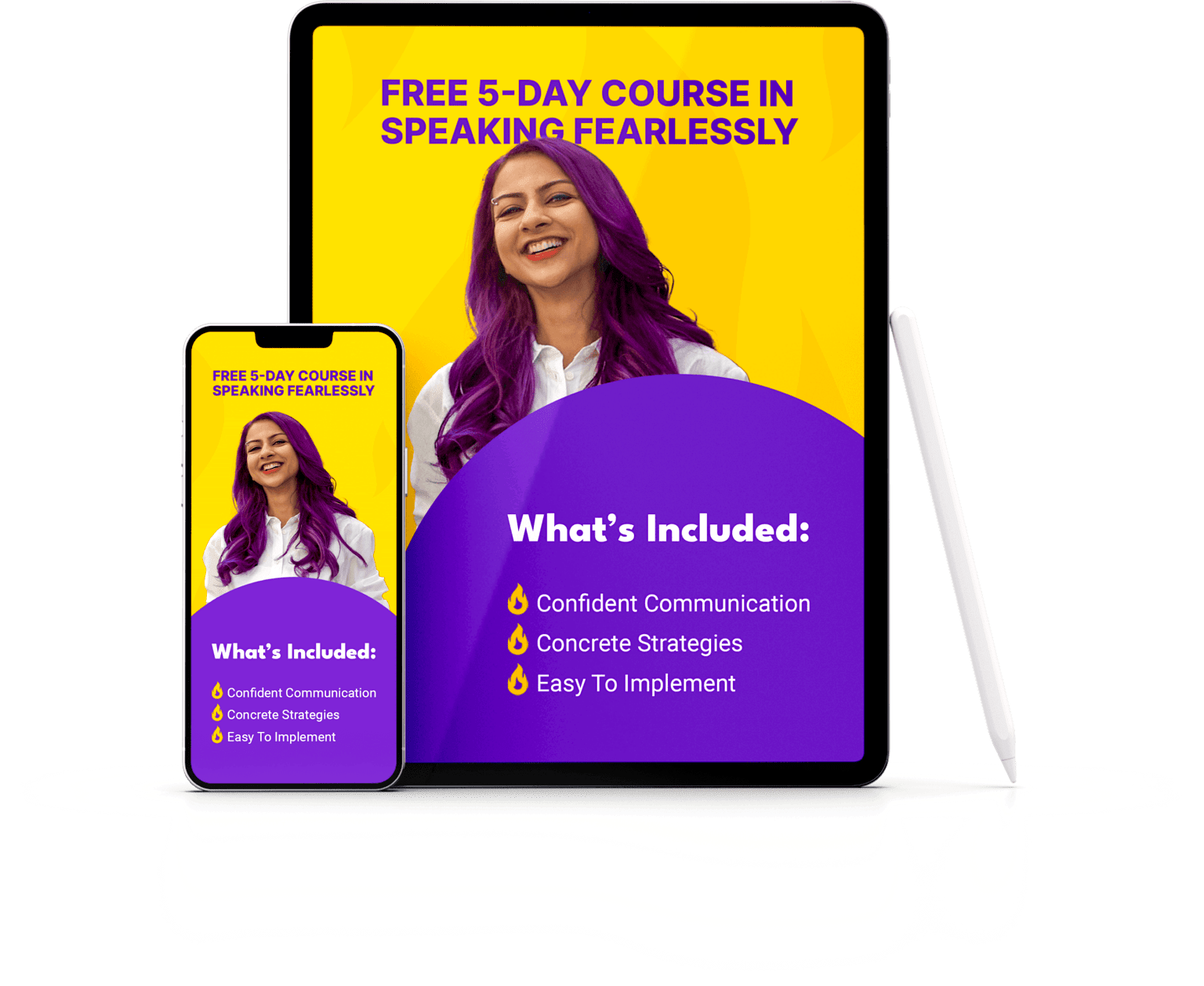You CAN speak confidently! Speaking in public – to an audience of any kind – can build thought leadership, influence and open many doors to success.
However, it’s also a massively anxiety-inducing endeavor. Confidence is a game-changer in public speaking. When a speaker portrays confidence on stage or on camera, they positively impact the audience’s perception, encouraging them to engage and influencing how their message is received and remembered.
Confidence is one of those sought-after qualities that’s as mysterious as it is in demand. Anyone who wants to excel at speaking in public wants to show confidence – which inspires trust and builds credibility in the speaker.
We all look enviously at well-known public speakers like Simon Sinek and Tony Robbins and marvel at the sheer confidence that they portray.
But the eternal question is – what comes first?
Confidence before the action or the action that builds confidence?
In this guide, we’ll explore how you can build confidence as you prepare for your next public speaking opportunity – and how you can use each speaking opportunity to keep building your confidence.
Table of Contents

Photo by Matthew Osborn on Unsplash
1. Understanding the Psychology of Speaking Confidently
Confidence is not something a person’s born with. It’s not a personality trait. It’s a behavior that we can intentionally show through a dynamic interplay of thoughts, emotions, and behaviors. Understanding the psychological underpinnings of confidence is the first step toward unlocking it on the stage. Self-perception, cognitive patterns, and past experiences shape our confidence levels.
Self-perception:
Our self-perception revolves around the stories we tell ourselves about who we are, why we are the way we are and what we can or can’t be. It becomes the lens through which we see ourselves- it encompasses our beliefs about our abilities, the value we place on our opinions, and the trust we invest in our capacity to effectively communicate.
Building confidence means challenging any limiting narratives of self-perception that we may have imposed on ourselves, like “I’m an introvert, so I can’t speak well in public”, or “I froze that time that I spoke in public so I’ll freeze next time too”.
We constantly assess ourselves and are influenced by our own perception of how articulate, knowledgeable and competent we are when it comes to commanding an audience’s attention. Positive self-perception can act as a bolstering force, while negative self-perception may contribute to self-doubt and diminished confidence.

Cognitive patterns:
Our cognitive patterns – the way we process information – influence how much confidence we feel and can portray. Positive cognitive patterns involve constructive self-talk, optimistic framing of challenges, and the ability to reframe setbacks as opportunities for growth.
However, negative cognitive patterns, such as catastrophic thinking or dwelling on past failures, can erode confidence and create mental barriers to effective public speaking.

Photo by Thirdman
Albert Bandura, who was a professor at Stanford and known as one of the most influential psychologists of all time studied people who failed or succeeded at doing different tasks.
Imagine you have two people. Confident Cathy and Insecure Ian. They’re playing a game of scrabble.
Insecure Ian has low self-confidence, and Confident Cathy is quite confident.
But somehow both players are getting the worst letters to make words with. They both keep failing to get good word scores. Confident Cathy, who has high self-confidence, will start trying harder. She will start thinking of unique words to make, different kinds of combinations.
Insecure Ian, who has low confidence, is likely to give up.
And based on this research, if Confident Cathy loses the game, she will say: “I didn’t try hard enough”. So Sarah’s self-confidence in her own abilities to win in the future does not get affected by this failure. She just tells herself, “Try harder next time!”
But if Insecure Ian loses the games he’ll say: “I wasn’t good enough”. And because he thinks that his failure was because of his own lack of abilities -he doesn’t believe he can win even in the future.
Being intentional about how you talk to yourself after a difficult or significant task can have a deep impact on your confidence.
Past experiences:
Our past experiences when it comes to speaking in public can have a significant impact on future confidence levels.
Positive past experiences, where we felt in control, received positive feedback, or successfully navigated speaking challenges can contribute to a positive reservoir of confidence. On the other hand if we’ve had past trauma on a stage – if we’ve gone blank, stumbled through our words or been challenged – we could be carrying long-lasting public speaking scars. These negative experiences need to be consciously addressed and reframed to foster confidence in future speaking engagements.

Image by benzoix on Freepik
Case study:
The one thing that surprised me when I started coaching clients on how to speak with more impact was the number of people who came to me with past trauma of being on stage.
Some people had become robotic or stiff when they spoke on camera in the past – and when they watched themselves back, it made them say: “That’s not me!”
Others had lost their train of thought and gone blank when they were in the spotlight.
Tina had experienced a severe case of stage fright: She was a newly appointed Director at a multinational bank. She was a quiet person who had shied away from the spotlight for most of her career. But in her new role, it was impossible. She was now part of the top management and had to deliver a talk in front of her entire local office (think 500+ people).
She walked on stage, looked at the crowd, and froze.
She couldn’t regain her composure and had to run off the stage in a panic.
When Tina and I started working together, I realized that her panic was induced by a combination of not feeling equipped to handle speaking situations and not having the right positive internal narrative in her head that supports the utilization of those skills.
We worked on preparing her with the right speaking skills. And then we built her internal confidence by creating a positive feedback loop: every time she spoke in any setting using the tools we discussed, she would debrief with herself, note her strengths and opportunities. Developing an understanding of her opportunity areas helped her keep honing her tools. But also clearly knowing her strengths and being aware of her progress added to that sense of confidence.
After a few months of working together, Tina was able to get back on stage and speak to an audience of 200 people.
It’s not that she stopped feeling fear. She was able to harness proof against that fear in the form of the tools she was now equipped with, and use it as ammunition. She countered the negative voice that said: “I don’t know what I’m doing” with “I’m equipped. I know I can do this because I’ve practiced and I know what I’m good at”.
That knowledge of your own strengths helps fortify you against the negative voices in your head. It helps give you ammunition against the next time you hear that inner voice that discourages you:
Inner voice: “I can’t do this”
Strength-based negation: “I’ve done X, I performed well at Y. I can certainly tackle Z. I am equipped”.
2. Identifying and Overcoming Public Speaking Anxiety
Anxiety often stands as a barrier to confidence. When you’re anxious, you often anticipate the worst case scenario. This builds more fear and apprehension and can quickly spiral out of control.
Confronting the fear is the first step toward building unshakable confidence. The key idea is to understand where that fear and anxiety stems from: is it fear of judgment, fear of being criticized, fear of losing credibility, fear of being challenged etc?
Once you have a clear idea of what kind of fear and inhibition is increasing your public speaking anxiety, you can put in place a strategy to address and counter it. For example, if you fear judgment by the audience, you can counter it by telling yourself that most people are there to learn, not to judge. In fact, the audience is rooting for you to do well. If you do well, they will have invested their time wisely in listening to you, so it’s as much a win for them as it is for you.

Here are key strategies to counter common fears:
- If you have a fear of being exposed as an imposter: tell yourself about how you’ll be sharing what you know is true, and that you can defend it if needed. In most cases, you’ll also likely have been asked by someone in a position of authority to speak – hence, you already have authority and credibility.
- If you have a fear of judgment and criticism: reflect on your relationship with external validation. Ask yourself how you can prepare for the opportunity in a way that lowers the stakes and the perceived risk of embarrassment.
- If you have a fear of being out of your depth or out of control: You have the power to decide if you’re nervous or simply excited. You can reframe the nervous energy into an opportunity to prove your value and to help. Think of nervousness as caring about the outcome.
3. Strategies to Cultivate Inner Confidence
True confidence originates from within.
I don’t want to show you how to project confidence but be riddled with self-doubt. I never want you to “fake it”.
Here are 3 key strategies to cultivate your inner confidence so you never have to “fake it”:
- Positive Self-Talk:
Cultivate a positive inner dialogue. Find and challenge limiting self-beliefs that you may be nurturing. Use your awareness of your strengths and opportunities to show the negative voices that they are baseless.
- Aim to “do it scared”:
You’ll always feel less than ready. But if you let that fear get in the way of taking action, you’re setting yourself up for a lose-lose situation. Not only will you not take action but you will also give ammunition to the negative voices – “I couldn’t do it that time, what makes me think I can do it now?”
The key is to not let that feeling of fear stop you from taking action. Doing the scary thing scared but doing it anyway helps you feel less scared the next time.

- Build intentional positive feedback loops:
Debrief with yourself after every difficult talk and critical meeting. Give future you ammunition to say: “I did that. I can do the next scary thing”.
4. The Power of Visualization in Building Confidence
Visualization is a powerful tool to enhance your inner confidence when you speak in public.
You can use visualization as a tool when you practice your talk or presentation, as well as when you think about or reflect on your upcoming (intimidating) speaking opportunity. Use these visualization strategies:
Create a Mental Blueprint:
When you practice, visualize both you and your audience.
Aim to vividly imagine yourself on stage or on camera – visualize the actual environment you’ll be in when you do your talk or presentation. See yourself speaking confidently and engaging your audience. Picture, the audience’s positive reactions, and the overall success of your presentation.
Engage All Senses:
Make your visualization experience as real as possible by engaging all your senses.
Imagine the feeling of the clothes that you’ll wear. Hear the applause of the audience. Feel the ground under your feet.
Visualize the Entire Process:
Don’t limit your visualization to just being on stage or on camera.
Visualize yourself on the car ride over to the venue. Or in the bathroom, getting ready before going on camera. Picture yourself preparing thoroughly, practicing with enthusiasm, and handling potential challenges with confidence. Visualizing the entire process instills a sense of control.
Aim to picture yourself doing well during the presentation – hitting all the key points.
Visualize your audience listening to you, engaging with you and appreciating your talk afterwards. Once you can see their faces in your mind, the idea of doing well will become more real.

5. The Role of Preparation in Building Confidence
Confidence is closely tied to preparation.
A lot of people misspend their prep time creating and perfecting their powerpoint slides but never practicing their delivery. Or sometimes people think they will “wing it”. That’s a recipe for potential disaster because winging it is inconsistent. Maybe you’ll be in a good mood and you’ll do well. Or maybe you’ll be thrown off by something – a tech issue, or an argument before your big talk. And because you haven’t practiced enough, you won’t be as fluid or seamless in your presentation as you may have been if you had taken the time to practice.
Practicing and knowing how to show up again and again builds our self-confidence and self-trust. That level of practice is proof for ourselves that we can show up, regardless of challenges, distractions or interruptions and perform well again and again.
6. Physical Confidence:
In addition to your mindset, you can also learn to project confidence in any situation through your body language.
Body Language: The Silent Messenger of Confidence
Body language speaks volumes before you utter a word.
The best part: you can project confident physical body language whether you’re speaking in person or on camera.
Understanding and refining your body language can significantly boost your perceived confidence on stage.
In person, aim to have a strong posture. Stand with your feet shoulder width apart and don’t sway from side to side or shift your weight.
When presenting online, sit with your butt firmly planted in your chair. Don’t swing your chair or shift around.
Being grounded makes you come across as stable, and animating your upper half shows dynamism.

Turning Nervous Energy into Dynamic Presence:
Nervous energy is a natural part of public speaking. Instead of viewing it as a hindrance, learn to transform this energy into a dynamic presence. If you’re feeling the nerves – take care of your hand movements and your stepping. Use gestures intentionally and add movement to your talk.
Eye Contact:
Maintain eye contact with the audience – whether you’re speaking in person or online.
In person – sweep the audience from time to time so that you’re paying attention to all parts of the room. Online, look directly into the camera when you present so that it looks like you’re looking straight at the participants.
When you speak, become aware of when you’re looking up or around. Breaking eye contact once in a while is totally fine – but when you do it too often, it becomes distracting.
Smile:
Get rid of that poker face. Smiling is the most underrated and yet the most effective way to gain the trust of your audience. A genuine smile exudes warmth, confidence and creates connection.
7. Harnessing the Voice: Confidence in Speech Delivery
Your voice is your most useful tool when it comes to portraying confidence.

Photo by Henri Mathieu-Saint-Laurent
You can measure and then increase the impact of your voice by focusing on the 5P framework:
- Pacing: Control your pace. Most people speak faster than they think they do. Once you control the pace at which you’re speaking, you can then play with the speeds to achieve certain effects – speed up to show higher energy or show items in a list stacking up. Slow down to add tension, drama or curiosity.
- Pauses: Pauses are the most underrated tool when it comes to your voice and vocal patterns. Most people are intimidated by pauses – they think that pauses are awkward. Or that the audience will get impatient if they pause. On the contrary – the audience will thank you for pausing so that they can reflect. And you will get a moment to breathe, take stock, adapt, change intonations. Win-win.
- Projection: Be aware of the volume of your voice. Don’t mumble. Project your voice from your chest or stomach instead of letting it originate just from your throat.
- Pitch: Aim to vary your pitch. Monotonous talks lack confidence. When you can control and then vary your pitch to achieve different kinds of effects – you are showing your audience that you’re in complete control.
Use a higher pitch to show excitement. Drop it down to show the gravity of a situation. Or use intonations and emphasis to show the importance of certain words or phrases.
- Pronunciation – or rather, enunciation: aim to enunciate your words clearly and all the way through. Avoid trailing off at the end. When you enunciate well, you send the signal – “every word I’m saying matters”.
8. Mindfulness Techniques for Confidence
Mindfulness is a transformative practice that can anchor you in the present moment and alleviate anxiety.
Use mindfulness techniques like being present in the moment, suspending judgment and acute observation to transform your self-consciousness into self-awareness. When you’re self-conscious you’re not in control – you let the environment and stress control your state of mind. But being self-aware lets you acknowledge your mental state without letting it affect your performance.
Check out detailed tips on how mindfulness can help you deliver better presentations and talks here.
9. Embracing Imperfection: A Key to Lasting Confidence

Perfectionism often undermines confidence.
A lot of people believe that they need to build their confidence and courage before taking on the bigger, more intimidating talks or presentations of their careers. The truth is – embracing imperfection is a liberating mindset that fosters lasting confidence. Taking imperfect action and iterating is better than letting the fear of imperfection stop you.
Seeing others – especially those who might be ahead of you in their career journey – as also works in progress helps water down that expectation of perfection.
10. The Continuous Journey: Growing Confidence Over Time
Confidence is not a destination; it’s a journey. Clichéd as that sounds – it’s been proven. The more you “feed” your confidence through mindset and building positive feedback loops as well as learning concrete tools, the more it grows.
Confidence is just another word for how much you take control of the situation.If you don’t feel like you’re in control, then even winning the biggest challenge will feel empty.
But if you know you’re controlling your own fate, losing will no longer shake you. That’s how you build unshakeable confidence, that you are in full control of – not a trophy that someone can break or credits that someone can steal.
But like a strong armor that you build by yourself to help you, protect you and empower you to win any battle life throws at you.
As we conclude this guide, you’re now armed with a comprehensive toolkit to unlock and enhance your confidence on any stage or camera. From understanding the psychological dynamics to practical strategies and real-life examples, the journey toward confident public speaking is within your grasp. Embrace the challenge, apply these strategies, and step onto the stage with the assurance that your confident voice will resonate with impact.
Want to become a more powerful speaker? Let’s talk.



